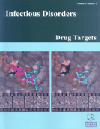- Home
- A-Z Publications
- Infectious Disorders - Drug Targets (Formerly Current Drug Targets - Infectious Disorders)
- Previous Issues
- Volume 8, Issue 3, 2008
Infectious Disorders - Drug Targets (Formerly Current Drug Targets - Infectious Disorders) - Volume 8, Issue 3, 2008
Volume 8, Issue 3, 2008
-
-
Editorial
More LessWith increasing interest in new drug and/or vaccine targets for the treatments of skin infectious diseases, this special issue is focused specifically on current advancements in antimicrobial peptides, vaccines as well as novel technologies for detection of skin microbiota [1]. The first paper, by Brigit Schittek, in this issue exemplifies various antimicrobial peptides or proteins (AMPs) in human skins and discusses their roles in a ra Read More
-
-
-
The Role of Antimicrobial Peptides in Human Skin and in Skin Infectious Diseases
More LessAuthors: Birgit Schittek, Maren Paulmann, Ilknur Senyurek and Heiko SteffenAntimicrobial peptides or proteins (AMPs) represent an ancient and efficient innate defense mechanism which protects interfaces from infection with pathogenic microorganisms. In human skin AMPs are produced mainly by keratinocytes, neutrophils, sebocytes or sweat glands and are either expressed constitutively or after an inflammatory stimulus. In several human skin diseases there is an inverse correlation between sever Read More
-
-
-
Toll-Like Receptors in Skin Infections and Inflammatory Diseases
More LessAuthors: Yuping Lai and Richard L. GalloThe skin is the ultimate example of the function of innate immunity, it alerts the host of danger by many systems including sensing pathogen-associated molecule patterns (PAMPs) through Toll-like receptors and other pattern recognition receptors (PRRs), yet normally provides defense without inflammation. The skin responds rapidly to invading microbes by producing antimicrobial peptides or other antimicrobial interme Read More
-
-
-
Biofilms in Skin Infections: Propionibacterium acnes and Acne Vulgaris
More LessAuthors: T. Coenye, K. Honraet, B. Rossel and H. J. NelisIt is generally accepted that many human infections are biofilm-related and that sessile (biofilm-grown) cells are highly resistant against antimicrobial agents. Propionibacterium acnes plays a role in the pathogenesis of acne vulgaris, a common disorder of the pilosebaceous follicles and it has been suggested that P. acnes cells residing within the follicles grow as a biofilm. Although P. acnes biofilms have not been obs Read More
-
-
-
Vaccine Therapy for P. acnes-Associated Diseases
More LessAuthors: Teruaki Nakatsuji, Lada Rasochova and Chun-Ming HuangRecent studies have afforded abundant evidences showing that Propionibacterium acnes (P. acnes) is involved not only in acne vulgaris, but also in many diseases, including endocarditis, endophthalmitis, osteomyelitis, joint, nervous system, cranial neurosurgery infections, and implanted biomaterial contamination. In spite of a range of P. acnes pathogenicity, its vaccine therapies have been studied much less intensively th Read More
-
-
-
Mass Spectrometry-Based Approaches for the Detection of Proteins of Staphylococcus Species
More LessAuthors: Yen-Peng Ho and P. M. ReddyMass spectrometry (MS) has become a powerful and popular method to analyze macromolecules from biological systems towards the application of clinical chemistry. Disease markers related to infections can be identified with MS analysis in combination with electrophoresis or chromatographic separations. Further, direct analysis of whole pathogenic bacterial cells (taken directly from a colony) by MS can reveal Read More
-
-
-
A Technological Update of Molecular Diagnostics for Infectious Diseases
More LessIdentification of a causative pathogen is essential for the choice of treatment for most infectious diseases. Many FDA approved molecular assays; usually more sensitive and specific compared to traditional tests, have been developed in the last decade. A new trend of high throughput and multiplexing assays are emerging thanks to technological developments for the human genome sequencing project. The applications of Read More
-
-
-
Topical Application of Escherichia coli Particles Over-Producing Pathogen-Derived Antigens as a Simple Vaccination Modality in Compliance with Evolutionary Medicine
More LessAuthors: Jianfeng Zhang and De-chu C. TangThe development of a new generation of vaccines that can be produced rapidly at low costs and massadministered noninvasively by non-medical personnel is crucial for boosting vaccine coverage in response to an escalation in demand. The demonstration that topical application of bioengineered nonreplicating Escherichia coli particles overproducing pathogen-derived antigens can mobilize the immune repertoire to Read More
-
-
-
Potential Roles of Histones in Host Defense as Antimicrobial Agents
More LessAuthors: H. Kawasaki and S. IwamuroAntimicrobial peptides (AMPs), which are widely distributed in various organisms, comprise part of the host innate defense system to kill or damage bacterial and fungal pathogens. Amphibian skin is known to produce various AMPs, and is used as a source material in attempts to identify novel therapeutic AMPs. More than one hundred frog AMPs have been identified to date. In our previous study, we isolated histone H2B with a Read More
-
Volumes & issues
-
Volume 25 (2025)
-
Volume 24 (2024)
-
Volume 23 (2023)
-
Volume 22 (2022)
-
Volume 21 (2021)
-
Volume 20 (2020)
-
Volume 19 (2019)
-
Volume 18 (2018)
-
Volume 17 (2017)
-
Volume 16 (2016)
-
Volume 15 (2015)
-
Volume 14 (2014)
-
Volume 13 (2013)
-
Volume 12 (2012)
-
Volume 11 (2011)
-
Volume 10 (2010)
-
Volume 9 (2009)
-
Volume 8 (2008)
-
Volume 7 (2007)
-
Volume 6 (2006)
Most Read This Month
Article
content/journals/iddt
Journal
10
5
false
en


